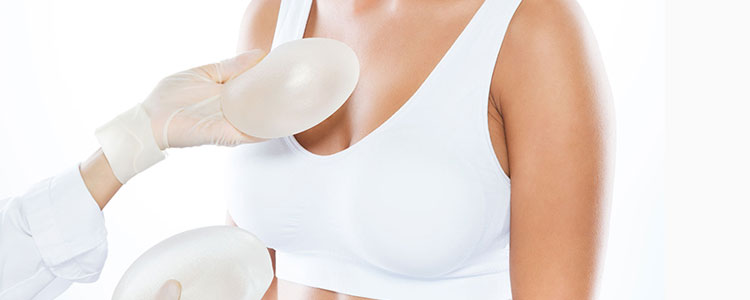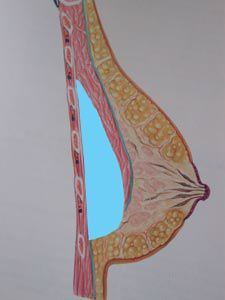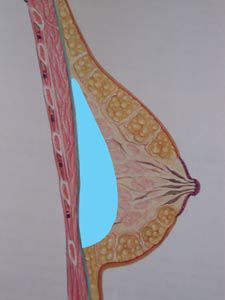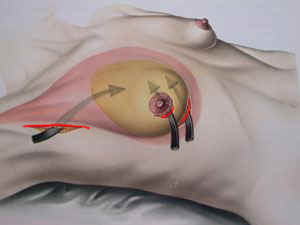MASTOPLASTY - INCREASE IN BREAST SIZE

Breast enhancement is intended to correct the defects of aesthetic breasts too small or slightly sagging.
Precisely for this reason the cost of the intervention is usually not covered by common insurance.
The intervention provides an increase in volume by introducing a prosthesis below the mammary gland or pectoral muscle with a pre-surgery study which gives most of the time the desired result. The choice of positioning the prosthesis is made based on the physical characteristics of the individual patient.
The intervention is made with general or local anesthesia.

Submuscular prosthesis

Subglandular prostheses
Those who choose to increase breast size
Increasing the breast size is normally practiced on patients with underdeveloped breasts, developed asymmetrically, or breasts that have lost volume after breastfeeding.
The patient who chooses to increase the breast size does this surgery almost exclusively for aesthetic reasons giving her more security, higher self-esteem, and personal satisfaction.
The intervention can be carried out by when the body has fully developed and does not prevent you from further breastfeeding.
The intervention
During this intervention, the implants are surgically introduced behind the mammary gland or pectoral muscle. Normally this prosthesis is a silicone pad filled with different substances. The outer sheath is usually double-layered silicone elastomers. This strengthens the resistance to injury and helps to make the breast more in a natural form and more natural also to the touch.
A new type of surface also removes the risk of forming a fibrous capsule around the implants.
Hydrogel, a filling substance is used today in silicone gel or saline solution. These materials make the prosthesis optically and to the touch almost perfectly equal to the natural state.
The access incision can be practiced in a natural crease under the breast, around the nipple, or under the arms. Through this opening, the surgeon obtains a space in which he inserts the silicon prosthesis. This happens behind the mammary gland or between the chest muscles and ribs.
Starting from your expectations and your physical condition discuss together with your plastic surgeons the position cut and the type and size of the desired implant.

What results are to be expected
With breast implants, you will get a full, very durable that keeps its form with very natural breasts that suit your body type, only appropriate to the natural expertise for many years practiced by the surgeon.
However, the aging process and the force of gravity mean that the shape of the breast with time will slowly change. The presence of the prosthesis does not eliminate the possibility of having a breast lift to rejuvenate their appearance in the future.
Anesthesia and recovery
Generally, you operate under general anesthesia in a local clinic. The pre-surgery examinations and the visit by the anaesthesiologist are made the day before in the same clinic. The hospital is a short stay and will be discharged after about 1-2 days after surgery.
In some cases, it is possible to make the intervention under local anesthesia from the doctors clinic of your plastic surgeon. A sedative will be administered that will enable you to be relaxed and in a state of drowsiness during the intervention. You can leave the clinic a few hours after the procedure.
Precautions
To minimize the risks and complications follow closely the instructions of your surgeon both before and after the procedure.
Communicate to your doctor if you suffer from allergies or other chronic diseases. If you bruise easily or if bleed excessively in a small injury, you may require some analysis to exclude difficulties of your blood to clot.
In some cases, as a precaution, it is prescribed a mammogram or an ultrasound first to rule out any changes in breast tissue.
They are aspirin-type painkillers to be avoided during the two weeks before the intervention because their active ingredient interferes with blood clotting and can cause excessive bleeding. You must avoid also alcohol and sleeping pills.
Communicate to your surgeon if you are planning a pregnancy or a hypocaloric diet. The shape of the breast may vary significantly by the outcome of the intervention.
If the intervention will be performed under local anesthesia consider that anesthetics, painkillers, or sedatives can affect your ability to react. Therefore you may need someone who accompanies you home after the intervention and that remains with you for the first 24 hours.
What should I do during intervention
After the anesthesia has been given, the surgeon will cut and insert the prosthesis that was agreed with you before the surgery. The cut will be made as small as possible. The formation of space that will hold the prosthesis requires a strong aesthetic sense by the surgeon since its location and its size determines the aesthetic result of the intervention. In the second case proceeds the filling through the insertion of the prosthesis with the amount of liquid physiological you have established.
An aesthetics stitch is made inside the skin assuring a virtually invisible scar and the area is then bandaged. The intervention takes about 45-60 minutes.
What happens after the intervention
Light pain will be felt for some days and there may be some bruising. These symptoms will slowly go away after a few days or weeks.
After 1-2 days you will feel better, and you can resume your work after about 1 week.
Note that you can not take a shower for a few days.
Once the bandage is removed, wear bras that support and do not tighten the breast. Keep them on about three weeks for 24 hours and on 24 for 3 more weeks at least during the day. The first 3 months after the intervention prevent from wearing a bra with the "push-up effect.
The scars fade away over time and will be practically invisible.
The result can be assessed after 6-9 months.
Possible complications
During the normal healing process, a layer around the implants will form. According to personal tendencies, this can remain tight and make the breast harder to touch. In the worst cases, this phenomenon can lead to pain, displacement of the prosthesis, or change the shape of the breast. In rare cases, another intervention may be necessary to enlarge the cavity in which there is the prosthesis or change it directly.
Like all synthetic materials including silicone there is subject to change and this can lead to defects in the case of prostheses.
Serious accidents can cause the rupture of implants despite the double layer of protection, causing leakage of material filling. In the case of prostheses a saline solution that poses no danger because the material is naturally absorbed by the body within hours.
The other substances instead can interact with surrounding tissues and cause months or years after the formation of silicone.
Prosthetics may temporarily reduce the sensitivity of the nipple. In extreme cases healing problems, oedema, infections, and the formation of seromi can occur and we must temporarily remove the implants.
If you make a mammography, your doctor will inform you of the presence of prostheses, because they can influence the outcome of the analysis.
Precautions after intervention
For two months treat your breasts gently (this also applies to your sexual partners). Avoid sports or home activities(ex. long iron) involving the chest muscles.
